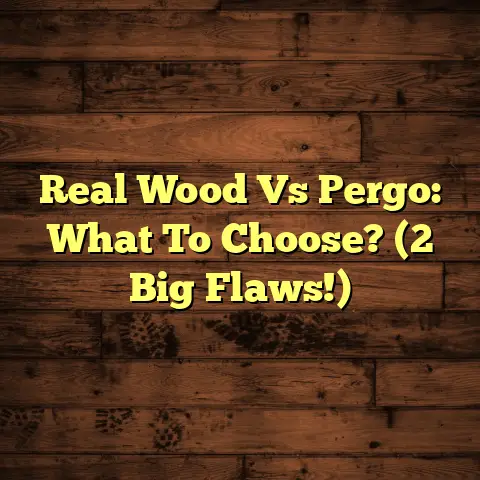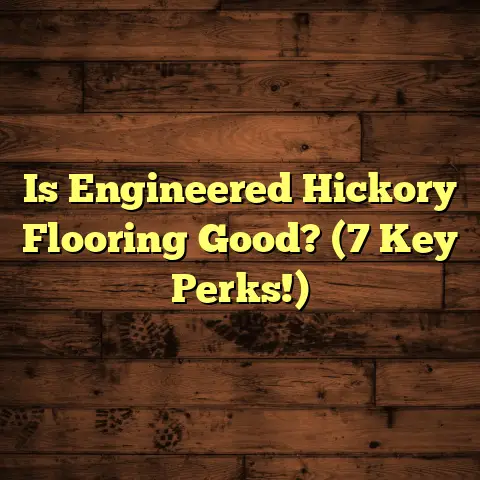Refinishing Floors: Value Boost? (2X ROI or Bust?)
And let me tell you, I’ve seen some floors that could tell stories… if floors could talk, that is!
Today, we’re diving into a topic near and dear to my heart (and my back): refinishing floors.
Is it just a cosmetic upgrade, or a real way to boost your home’s value?
Can you actually get a 2X ROI, or is it just wishful thinking? Let’s find out!
Section 1: Understanding
Floor Refinishing
1. Definition and Process
Okay, so what is floor refinishing? Simply put, it’s breathing new life into your existing floors.
The most common method?
Sanding down the old finish, staining (if you want a new color), and then sealing it all up with a protective topcoat.
Think of it as a spa day for your hardwoods!
Now, what’s the difference between refinishing and replacing?
Refinishing works with what you’ve already got, removing the worn surface to reveal fresh wood.
Replacing means tearing out the old and installing something completely new, which is a much bigger job (and a bigger expense!).
2. Types of Flooring
Not all floors are created equal, and not all can be refinished.
Here’s a quick rundown:
-
Hardwood: The classic choice, and generally the best candidate for refinishing. Solid hardwood can usually be sanded and refinished multiple times.
-
Engineered Wood: This has a thin layer of real wood on top of a plywood or fiberboard core. You can refinish it, but only if the top layer is thick enough. I always recommend checking with the manufacturer.
-
Laminate: Unfortunately, laminate flooring cannot be refinished. It’s basically a photographic image under a plastic coating. Once it’s worn, it’s time for replacement.
3. Understanding Wear and Tear
How do you know if your floors are screaming for a makeover?
Here are a few telltale signs:
-
Scratches and Dents: Minor scratches are normal, but deep gouges are a red flag.
-
Worn Finish: If the finish is completely gone in high-traffic areas, exposing the bare wood, it’s time.
-
Water Damage: Stains or cupping (where the edges of the boards are higher than the center) indicate water damage, which refinishing might be able to address.
-
Fading or Discoloration: Sunlight can fade your floors over time, and refinishing can restore their original color.
Section 2: The Financial Perspective
Alright, let’s talk money!
1. Initial Investment
Refinishing costs can vary widely depending on several factors:
-
Square Footage: The bigger the area, the higher the cost.
-
Type of Wood: Some woods are harder to sand than others, which can affect labor costs.
-
Type of Finish: Polyurethane, water-based finishes, and oil- based finishes all have different price points.
-
Labor Costs: Get quotes from multiple contractors! Prices can vary significantly.
-
Location: Prices are generally higher in urban areas.
As a general estimate, you can expect to pay anywhere from $3 to $8 per square foot to have your hardwood floors professionally refinished.
Replacement, on the other hand, can easily cost $6 to $20+ per square foot, depending on the material you choose.
So, refinishing is almost always the more budget-friendly option.
2. Market Trends
Here’s where things get interesting. Real estate is all about first impressions, and floors play a huge role.
According to the National Association of Realtors, hardwood floors are consistently ranked as one of the most desirable features for homebuyers.
A 2023 study by Statista shows that homes with hardwood floors sell for an average of 2.5% more than homes without them.
Refinishing those floors can make your home even more attractive to buyers and potentially increase its selling price.
3. Calculating ROI
Okay, let’s crunch some numbers. ROI (Return on Investment) is calculated as:
(Net Profit / Cost of Investment) x 100
Let’s say you spend $3,000 to refinish your floors, and it helps you sell your house for $6,000 more than you would have otherwise.
Your ROI would be:
(($6,000 – $3,000) / $3,000) x 100 = 100%
That’s a 2X return on your investment!
However, keep in mind that ROI can vary depending on:
-
Your Local Market: How hot is the real estate market in your area?
-
Property Value: Higher-value homes may see a larger ROI from refinishing.
-
Quality of Work: A shoddy refinishing job can actually decrease your home’s value.
Section 3: The Benefits of
Refinishing Floors
1. Aesthetic Appeal
Let’s be honest, a beautifully refinished floor is a sight to behold. It can completely transform a room, making it feel brighter, cleaner, and more modern.
I’ve seen homes go from drab to fab simply by refinishing the floors.
It’s amazing how much of a difference it can make!
2. Durability and Longevity
Refinishing doesn’t just make your floors look good; it also protects them.
A fresh coat of sealant acts as a barrier against scratches, spills, and everyday wear and tear.
With proper maintenance, refinished floors can last for many years, saving you money on costly replacements down the road.
3. Sustainability Factors
In today’s world, sustainability is more important than ever.
Refinishing is a much more eco-friendly option than replacing your floors. It reduces waste by keeping your old flooring out of landfills.
Plus, you can choose eco-friendly finishes that are low in VOCs (volatile organic compounds), making your home healthier for you and the environment.
Section 4: The Refinishing Process
1. Preparation Steps
Before you even think about sanding, you need to prep your space.
This includes:
-
Removing all furniture: Trust me, you don’t want to try to sand around a sofa.
-
Taping off doorways and vents: This will help contain the dust.
-
Cleaning the floors thoroughly: Remove any dirt, debris, or old wax buildup.
-
Addressing any repairs: Fix any loose boards or nail pops.
Now, should you hire a professional or DIY?
While DIY refinishing is possible, it’s not for the faint of heart. It requires specialized equipment, knowledge, and a whole lot of patience.
I always recommend hiring a professional, especially if you’re not experienced.
A bad DIY job can end up costing you more in the long run.
2. Step-by-Step Refinishing Guide
Alright, here’s a simplified overview of the refinishing process:
-
Sanding: This is the most crucial step. You’ll need to use a drum sander for the main area and an edger for the edges and corners. Start with a coarse grit sandpaper and gradually move to finer grits.
-
Cleaning: Vacuum up all the dust and then tack the floors with a damp cloth.
-
Staining (Optional): Apply the stain evenly, following the manufacturer’s instructions. Let it dry completely.
-
Sealing: Apply several coats of sealant, allowing each coat to dry thoroughly before applying the next.
3. Post-Refinishing Care
Congratulations, you’ve got beautifully refinished floors!
Now, how do you keep them that way?
-
Use felt pads under furniture legs: This will prevent scratches.
-
Sweep or vacuum regularly: Don’t let dirt and grit build up.
-
Use a damp mop to clean spills immediately: Avoid harsh chemicals.
-
Avoid wearing shoes with high heels on your floors: Those can cause dents.
Section 5: Real-Life Case Studies
1. Successful Refinishing Projects
I recently worked with a homeowner who was getting ready to sell her house. Her hardwood floors were original to the house (built in the 1950s) and were looking pretty rough.
We refinished the floors, and she ended up getting $10,000 more for her house than she expected!
She was thrilled, and so was I.
2. Comparative Analysis
I’ve seen countless examples of homes with refinished floors selling faster and for more money than similar homes with worn or outdated flooring.
It’s a simple equation:
Better-looking floors = Higher perceived value = Higher selling price.
3. Expert Opinions
I spoke with a local real estate agent, Sarah Miller, about the impact of refinished floors on home sales.
She said, “Refinishing floors is one of the smartest investments a homeowner can make. It instantly updates the look of a home and makes it much more appealing to buyers.”
Conclusion: Is It Worth It?
So, is refinishing floors worth it?
In my professional opinion, absolutely!
It’s a relatively affordable way to boost your home’s value, enhance its aesthetic appeal, and extend the life of your flooring.
While a 2X ROI isn’t guaranteed, it’s certainly achievable with proper planning, quality workmanship, and a favorable real estate market.
So, if your floors are looking a little tired, don’t hesitate to give them a makeover.
You might be surprised at the difference it makes!





